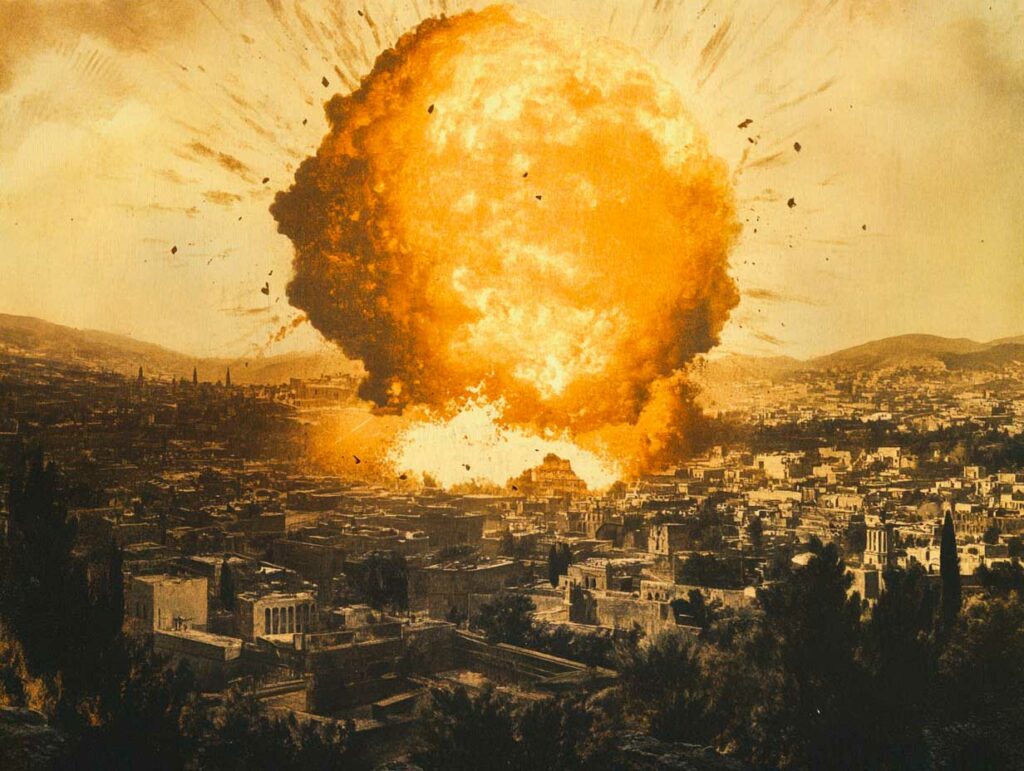
How do bombs explode? Whether in the air or on the ground, each strategy maximizes effectiveness in different ways. Explanation of the different types of explosion.
The different ways bombs explode: on the ground or in the air
The question of whether bombs explode on the ground or at altitude reveals the breadth of modern military strategies and the different objectives they aim to achieve. Depending on the nature of the target, the configuration of the terrain and the desired effect, bombs are designed to explode either when they reach the surface, or at a certain altitude before impact. Both methods have their advantages and are used to meet different needs, with particular consequences in terms of damage and area coverage.

Ground blast: targeted destruction
Ground detonation is probably the most intuitive and common method used in modern military conflicts. These bombs are designed to make contact with a target before detonating, generally to cause maximum concentrated damage. An impact bomb, fitted with a detonator, is activated when the device hits the ground or a predefined target, releasing all its energy at a precise point.
Anti-bunker bombs are a good example of this type of explosion. These weapons are specifically designed to penetrate fortified structures before exploding, maximizing damage inside. For example, the GBU-28, an American guided bomb, is capable of penetrating several meters of reinforced concrete before detonating, making it ideal for destroying underground bunkers or strategic installations.
In addition to anti-bunker bombs, cluster bombs also explode on impact with the ground. When detonated, they scatter metal fragments in all directions, causing extensive damage to multiple targets in a precise area. This makes them particularly effective against troop formations or unarmored vehicles. A notorious example is the use of cluster bombs during the Gulf War, causing heavy casualties among Iraqi forces and also affecting civilian infrastructure.
Explosion at altitude: maximizing the blast wave
Unlike bombs exploding on the ground, bombs exploding at altitude are designed to maximize the surface area of effect and cause damage over a much wider area. This technique, known as “airburst”, is often used when the aim is to cause widespread destruction rather than targeting a specific point.
When a bomb explodes at altitude, the energy of the blast propagates through the air before hitting the ground, generating an extremely powerful blast wave. This wave is capable of destroying unreinforced structures, overturning vehicles and causing heavy casualties among exposed enemy troops. Nuclear bombs are the best-known example of high-altitude explosions. The bomb dropped on Hiroshima in 1945 exploded some 600 meters above the city, allowing the blast wave and thermal radiation to spread over a wide area, causing enormous loss of life and massive destruction.
Cluster bombs can also be detonated at altitude to spread hundreds of small explosive charges over a large area, increasing the probability of hitting a maximum number of enemy targets. This is the case with the American CBU-87 bombs, which are designed to release up to 200 submunitions, each fitted with an individual detonating charge. By exploding at altitude, they maximize the dispersal effect and create a “shower” of secondary explosions over a vast area.
Factors determining the type of explosion
The choice between a ground or high-altitude explosion depends on a number of factors, including the type of target, the desired effect, and the characteristics of the terrain. Underground or fortified targets require impact bombs, capable of penetrating protection before detonating. Conversely, to cause massive casualties among dispersed troops or destroy unreinforced infrastructure, a high-altitude explosion can be far more effective.
Modern technology makes it possible to pre-programme the exact height of an explosion using sophisticated fuses. GPS-guided bombs, for example, can be programmed to detonate at a precise height above the target, guaranteeing maximum effectiveness according to battlefield requirements. The BLU-129/B system, for example, is a precise weapon that minimizes collateral damage thanks to adaptable programming of the point of detonation.

Humanitarian and strategic consequences
The consequences of these two types of explosion also vary. A ground explosion often causes concentrated damage, which may reduce collateral damage in a densely populated area but increase damage to the desired target. High altitude explosive bombs, on the other hand, have a widespread impact that can cause significant collateral damage and affect civilian populations if misused, or if the target area is close to populated centers.
High-altitude bombing is controversial for this reason, particularly when cluster bombs are used, which often leave unexploded submunitions. These “time bombs” pose a danger to civilian populations long after hostilities have ended, causing injury or death to those who unwittingly handle them. The conflict in Kosovo is a striking example, where numerous submunitions caused casualties among the civilian population years after the fighting had ended.
–
The effectiveness of a bomb and whether it is detonated on the ground or at altitude depend largely on the military strategy employed, the nature of the target and the desired effects. A ground explosion is ideal for fortified or precise targets, while an explosion at altitude maximizes the blast wave and fragmentation effect over a wide area. The choice between these two approaches is often dictated by tactical objectives, but it also involves important humanitarian considerations, particularly with regard to collateral damage and risks to civilians.
So how bombs are detonated – on the ground or in the air – is a complex issue, closely linked to strategic intentions and battlefield realities. These different modes of explosion reflect the evolution of military technologies and the constant effort to maximize effectiveness while limiting, as far as possible, the humanitarian consequences. The use of such weapons is never without risk, and raises important ethical questions, particularly when the boundary between military targets and civilian populations becomes blurred.
War Wings Daily is an independant magazine.